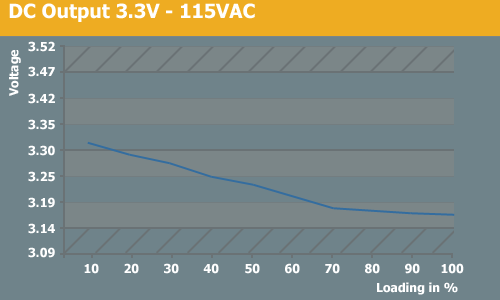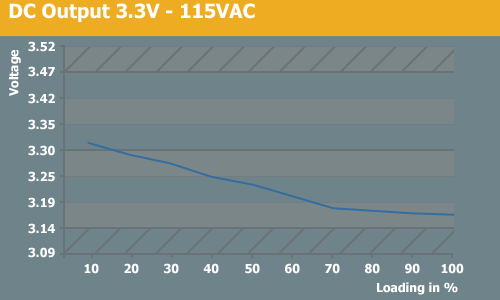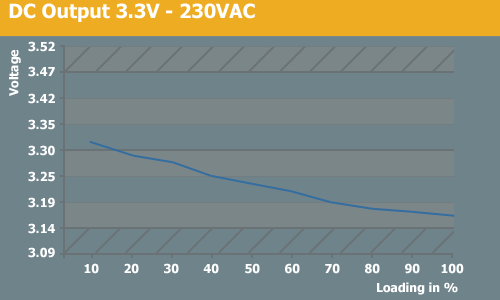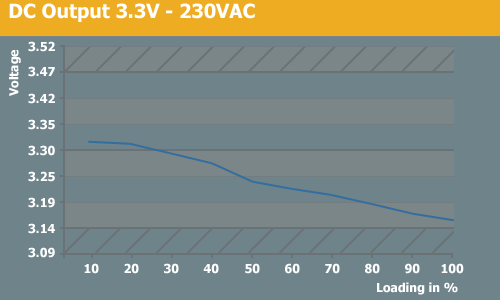Gigabyte's New Odin GT 800W Power Supply
by Christoph Katzer on July 24, 2007 12:01 AM EST- Posted in
- Cases/Cooling/PSUs
3.3V DC Output
Starting with the 3.3V rails we encounter slight problems. At lower loads there's nothing to concern us, but as the load rises the 3.3V rail drops tremendously and barely manages to stay within specification. As we will describe later on we have measured the same low voltages with the P-Tuner software which confirms our readings, and we will see this pattern on all of the other rails. It's not only at higher temperatures that this power supply delivers lower voltages; we found even at room temperature where the internal components should stay cooler that we still get large voltage drops.
The heatsinks don't get too hot like as we will see later, but since we only measure the heatsinks we don't know the exact temperatures of the other components on the PCB. As we mentioned earlier, we think that the heatsinks may be too big to let any air through to the components on the board. The dropping voltages could be a result of this.




| 3.3V DC Output | |||
| Percentage | Amperage | Wattage | Wattage (All rails combined) |
| 10% | 1.92 | 6.36 | 77.95 |
| 20% | 3.85 | 12.67 | 158.11 |
| 30% | 5.77 | 18.87 | 236.48 |
| 40% | 7.7 | 25.03 | 314.35 |
| 50% | 9.62 | 31.07 | 391.55 |
| 60% | 11.55 | 37.08 | 467.94 |
| 70% | 13.47 | 42.97 | 544.95 |
| 80% | 15.4 | 48.82 | 620.44 |
| 90% | 17.32 | 54.39 | 695.26 |
| 100% | 19.25 | 60.06 | 769.57 |
Starting with the 3.3V rails we encounter slight problems. At lower loads there's nothing to concern us, but as the load rises the 3.3V rail drops tremendously and barely manages to stay within specification. As we will describe later on we have measured the same low voltages with the P-Tuner software which confirms our readings, and we will see this pattern on all of the other rails. It's not only at higher temperatures that this power supply delivers lower voltages; we found even at room temperature where the internal components should stay cooler that we still get large voltage drops.
The heatsinks don't get too hot like as we will see later, but since we only measure the heatsinks we don't know the exact temperatures of the other components on the PCB. As we mentioned earlier, we think that the heatsinks may be too big to let any air through to the components on the board. The dropping voltages could be a result of this.














23 Comments
View All Comments
mostlyprudent - Tuesday, July 24, 2007 - link
Read the test methodology article.neogodless - Tuesday, July 24, 2007 - link
Did you find any issues with the modular design? Obviously the efficiency was good. Could anything else have been affected by the additional connection point?Christoph Katzer - Tuesday, July 24, 2007 - link
I am in the midle of testing that with other models. I will write something which will bring light in this in matter...